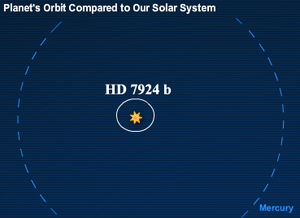HD 7924 b
| Exoplanet | List of exoplanets | |
|---|---|---|
 | ||
| Parent star | ||
| Star | HD 7924 | |
| Constellation | Cassiopeia | |
| Right ascension | (α) | 01h 21m 59.11s[1] |
| Declination | (δ) | +76° 42′ 37.0″[1] |
| Apparent magnitude | (mV) | 7.185 |
| Distance | 54.8 ± 0.3[1] ly (16.8 ± 0.1[1] pc) | |
| Spectral type | K0V | |
| Orbital elements | ||
| Semi-major axis | (a) | 0.057 AU (8.5 Gm) |
| Periastron | (q) | 0.047 AU (7.1 Gm) |
| Apastron | (Q) | 0.067 AU (10 Gm) |
| Eccentricity | (e) | 0.17 ± 0.16 |
| Orbital period | (P) | 5.3978 ± 0.0015 d |
| Orbital speed | (υ) | 115 km/s |
| Argument of periastron |
(ω) | 25 ± 60° |
| Time of periastron | (T0) | 4727.27 ± 0.87 JD |
| Physical characteristics | ||
| Minimum mass | (m sin i) | 0.029 MJ (9.2 M⊕) |
| Discovery information | ||
| Discovery date | January 28, 2009 | |
| Discoverer(s) | Howard et al. | |
| Discovery method | radial velocity | |
| Discovery status | Published[2] | |
| Database references | ||
| Extrasolar Planets Encyclopaedia | data | |
| SIMBAD | data | |
| Exoplanet Archive | data | |
| Open Exoplanet Catalogue | data | |
HD 7924 b is an extrasolar planet located approximately 54 light years away in the constellation of Cassiopeia, orbiting the 7th magnitude K-type main sequence (slightly metal poor) star HD 7924.[2] It was published on January 28, 2009 and is the second planet discovered in the constellation Cassiopeia. (The first planet discovered in this constellation is HD 17156 b, which was published on April 14, 2007).
Super-Earth
HD 7924 b is a super-Earth exoplanet with a minimum mass 9.2 times that of Earth and takes only about 129.5 hours to orbit the star, at an average distance of 8,500,000 km (5,300,000 mi). When HD 7924 b was discovered in 2009, it was one of only eight planets known with a minimum mass less than 10 Earths.[2] Also a super-Earth discovery makes 2009 the fifth year in a row since 2005 to have super-Earth planets discovered.
Characteristics
While the radius of HD 7924 b is unknown, depending on its composition, it will be between 1.4–6 times the diameter of the Earth.[2] It is unknown whether this planet is rocky or gaseous. Since the true mass of this planet is not known, it might be gaseous if the true mass is considerably more than minimum mass. If the true mass is near the minimum mass of 9.2 ME, then this planet could be rocky.
References
- 1 2 3 4 van Leeuwen, F. (2007). "Validation of the new Hipparcos reduction". Astronomy and Astrophysics. 474 (2): 653–664. arXiv:0708.1752
 . Bibcode:2007A&A...474..653V. doi:10.1051/0004-6361:20078357. Vizier catalog entry
. Bibcode:2007A&A...474..653V. doi:10.1051/0004-6361:20078357. Vizier catalog entry - 1 2 3 4 Howard, Andrew W.; et al. (2009). "The NASA-UC Eta-Earth Program. I. A Super-Earth Orbiting HD 7924". The Astrophysical Journal. 696 (1): 75–83. arXiv:0901.4394
 . Bibcode:2009ApJ...696...75H. doi:10.1088/0004-637X/696/1/75.
. Bibcode:2009ApJ...696...75H. doi:10.1088/0004-637X/696/1/75.
External links
- "HD 7924 b". Exoplanets.
Coordinates: ![]() 01h 21m 59.1153s, +76° 42′ 37.024″
01h 21m 59.1153s, +76° 42′ 37.024″